How Prescribed Burns Aid Endangered Species, Restore Grasslands and Help Train Troops (Among Other Things)
By Paula Levihn-Coon
Reporting Texas
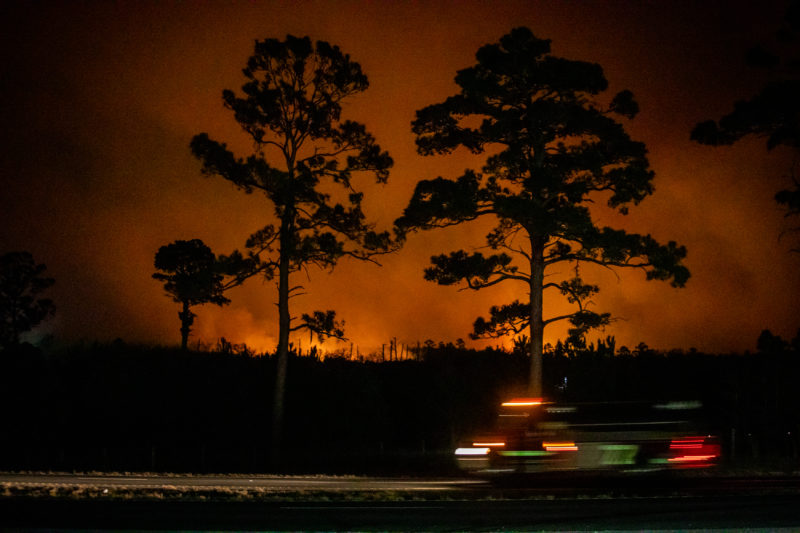
Flames rise from the Rolling Pines fire near Bastrop, Texas, after a prescribed burn got out of control on Jan. 18, 2022. The fire led to evacuations of the area and consumed 813 acres. Michael Minasi/KUT
A 150-acre prescribed burn intended to prevent wildfires in Bastrop State Park escaped control in January and consumed 813 acres. At least 250 families evacuated, reviving memories for some of a much larger 2011 wildfire in the same area.
Many in Bastrop expressed their ire on Facebook. The hashtag #rollingpinesfire became a repository of their comments.
“Omg! A controlled burn on a windy day like this? What genius authorized that?” Vickie Smith Hagedorn wrote.
“Why in the world would the State Park decide to control burn 150 acres. Someone needs to get their walking papers,” Lois Dennis Turner wrote.
Despite anger, questions and investigation sparked by that fire, experts say prescribed fires are a safe and cost-effective tool to improve habitat for endangered animals, to restore grasslands, and to remove invasive species. Of thousands of prescribed burns that are ignited every year, only about 1% escape, according to a study by the Great Plains Fire Science Exchange.
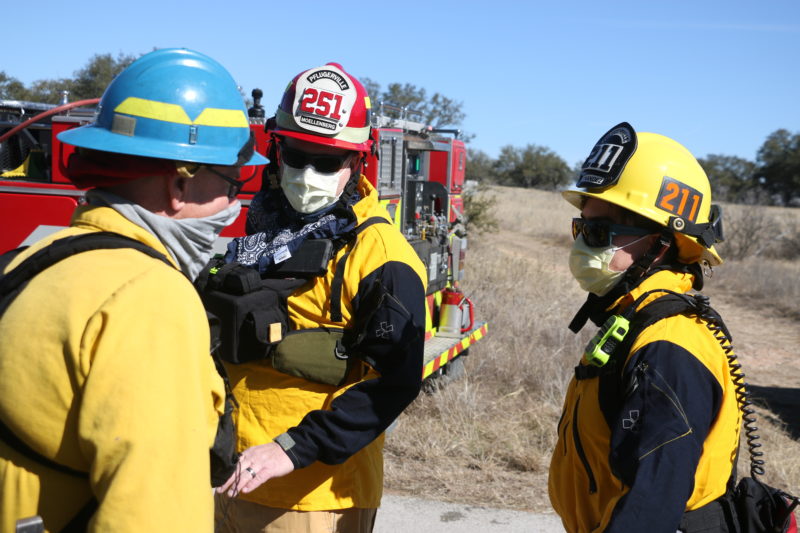
Jayson May, left, land management crew supervisor of the Travis County Parks Department goes over the burn plan members of the Pflugerville Fire Department prior to a prescribed burn at Milton Reimers Ranch outside Austin, Texas, on Feb. 9, 2022. Adam Shellooe/Reporting Texas
The low rate of escape is due to methodical precautions, experts say. Land management and fire experts spend days, weeks or even years planning burns.
“Prescribed burns are conducted by large, highly trained crews with ample fire engines, pumps and water reserves onsite to contain the fire,” Cait McCann, the city of Austin’s environmental program coordinator, said in a statement to Reporting Texas. Those precautions include creating firelines – breaks in vegetation on a fire’s perimeter – which are sometimes staffed with firefighting crews, McCann said.
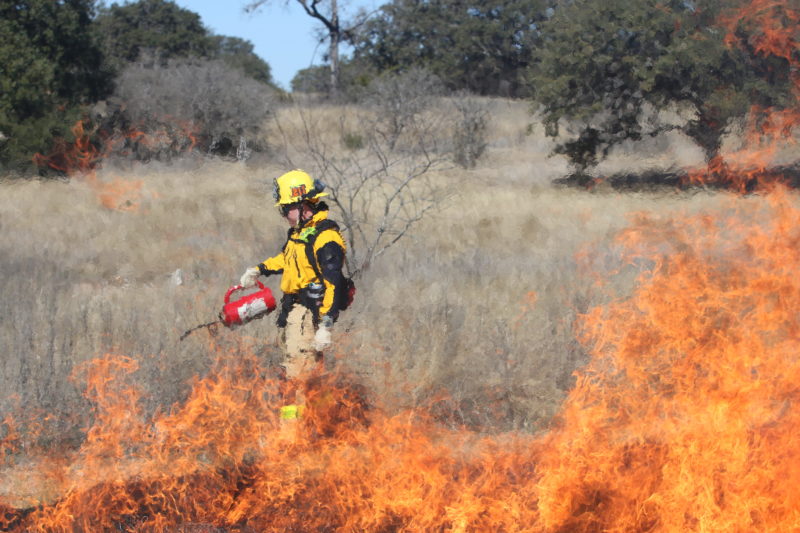
Heat waves surround Pflugerville firefighter Michael Hernandez during a prescribed burn at Milton Reimers Ranch outside of Austin, Texas, on Feb. 9, 2022. Adam Shellooe/Reporting Texas
Help for endangered species
In Central Texas in the 1990s, development was limited on almost 60,000 acres — on both the Balcones Canyonlands Preserve and the Balcones Canyonlands National Wildlife Refuge — to provide habitat for endangered species including the black-capped vireo, a bird with a black head and white spectacle-like markings on its face that weighs as much as two sheets of paper.
“(The birds are) dependent on periodic fire to maintain the patchy scrub-oak habitat they desire,” said Paul Fushille, a Travis County natural resources specialist. “Fire suppression has allowed much of the potential habitat to grow too thick.”
Decades of habitat restoration, in part through prescribed burns, led to the bird’s removal from the federal endangered species list in 2018, according to the U.S. Forest Service.
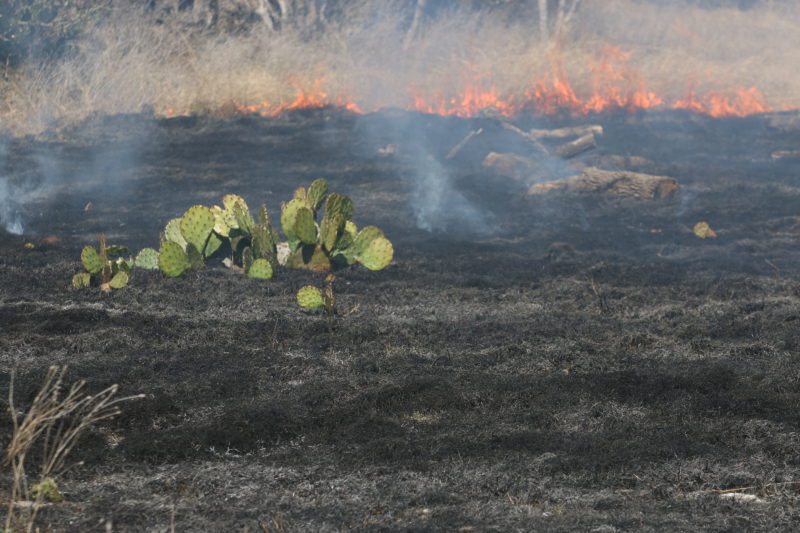
Prescribed burns like the one initiated at Milton Reimers Ranch on Feb. 9, 2022, have created a better habitat for the black-capped vireo which was removed from the endangered species list in 2018. Adam Shellooe/Reporting Texas
At Milton Reimers Ranch Park, a Travis County park west of Austin, vireos settled in and started breeding just a few years after prescribed burns began in summer 2015.
“We had vireos occasionally popping in up there and then we started burning and now the population is growing really quickly,” said Julie Murray, a natural resources specialist at Travis County Transportation and Natural Resources.
On Feb. 9 Travis County carried out its first routine prescribed burn at Reimers Ranch since the Rolling Pines Fire in Bastrop.
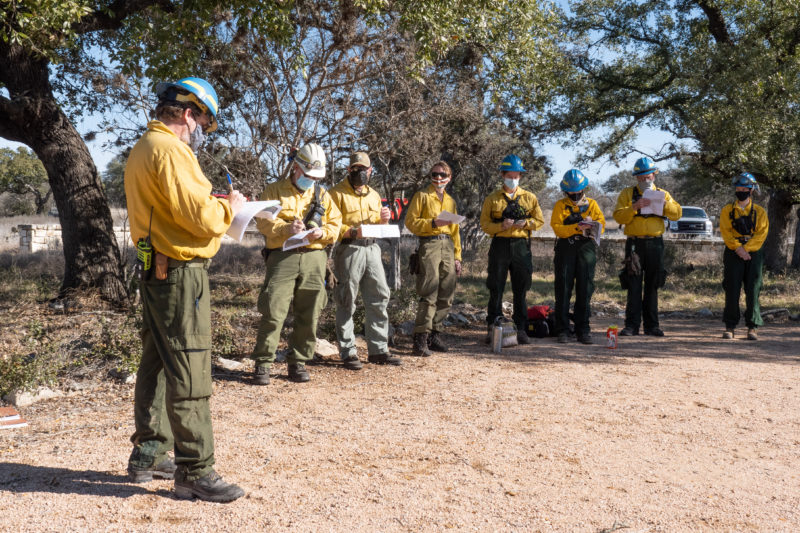
Burn boss Glen Gillman, left, briefs his team prior to conducting a prescribed burn at Milton Reimers Ranch Park on Feb. 9, 2022. The burn plan for the fire was 50 pages long and included information like weather predictions, maps of the area and radio frequency information in case of an emergency. Paula Levihn-Coon/Reporting Texas
Before the 70-acre burn at Reimers Ranch, burn boss Glen Gillman reviewed a 50-page burn plan with a two dozen person crew. “Everyone needs to be on their game because the value we have at risk is the public trust,” Gillman said. “We’re out here to show we can do these projects … These are things we do routinely.”
Restoring grassland
After many prescribed burns, particularly those done to kill invasive species, land is seeded with native grasses — such as little bluestem and Canada wild rye — and pollinator plants such as milkweed, to return it to a more natural state.
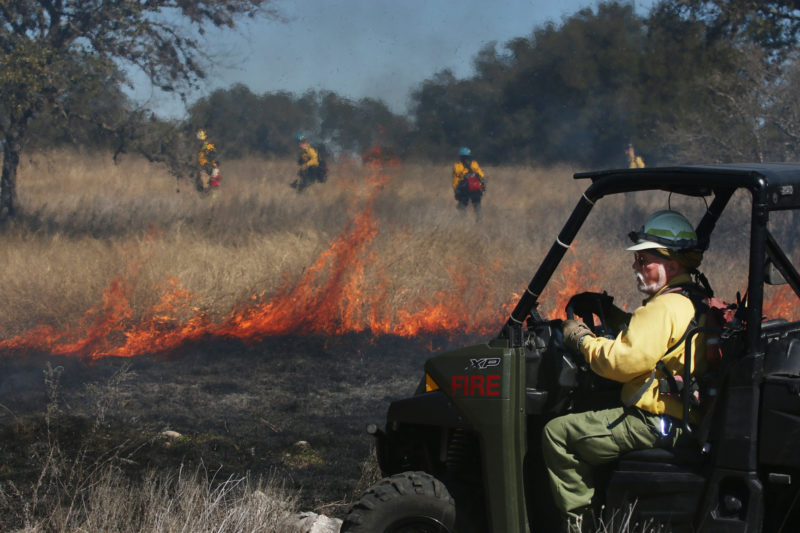
Nathan Decker with the Texas A&M Forest Service keeps an eye on a prescribed burn at Milton Reimers Ranch. Burns help restore native grasses and eliminate invasive plant species. Adam Shellooe/Reporting Texas
Grassland creation through prescribed burning helps Texas ranchers increase the protein content and amount of forage for their livestock and wild game — such as quail, turkey and exotic animals — said John Walker, a Texas A&M University range specialist who helps landowners maximize their land’s productivity.
The Hill Country’s 11,000-acre Lazy CK Ranch periodically burns 15% to 20% of its land to provide habitat for animals clients might pay $20,000 to hunt.
“We are a native and exotic game ranch, so the more we can get out of mother nature and take care of the range habitat, the less we have to input into it and them,” said Allen Robinson, the ranch’s general manager.
Besides creating better grazing lands, native grasslands over aquifer recharge zones help improve groundwater by reducing flooding and allowing water to sink underground, according to a city of Austin report.
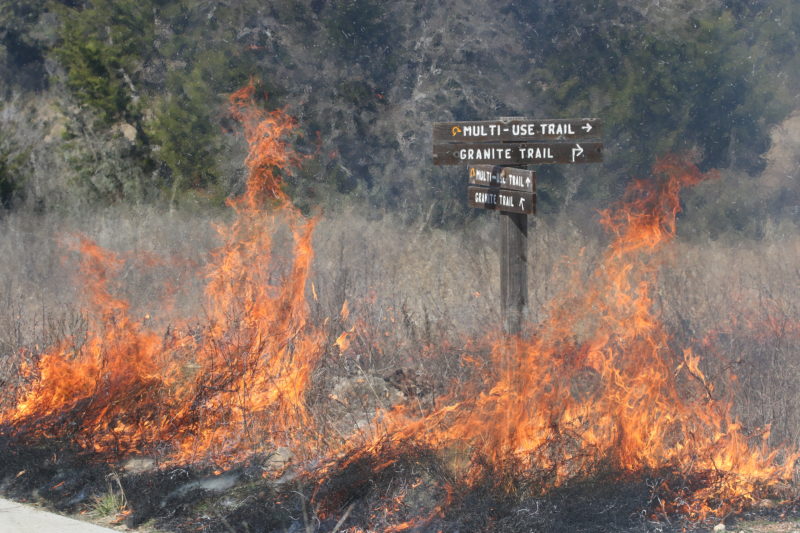
Prescribed burns such as the one conducted in February at Milton Reimers Ranch outside of Austin, Texas, not only help restore grasslands but also help improve the groundwater. Adam Shellooe/Reporting Texas
Austin uses prescribed burns on 28,000 acres of Water Quality Protection Lands from north of Kyle to Barton Springs to promote native grasses that filter water into the Edwards Aquifer. Tree canopy can also keep water from reaching the ground, Walker said.
Controlling invasive species
King Ranch bluestem, a grass native to Europe and Asia, was imported to South Texas’ King Ranch in the late 1800s and early 1900s as a foraging grass for animals and spread to most of Texas. The grass has been linked to a reduction in native plant and animal species and is very difficult to eradicate.
Data from a 20-year prescribed burn study on 70 acres at the Lady Bird Johnson Wildflower Center in Austin shows prescribed burns can help control the grass.
Prescribed burning alone, however, may not be enough to control all unwanted plants.
Some plants, such as mesquite and redberry juniper, both prolific on Texas’ Edward Plateau because of overgrazing, resprout after a burn.
That’s where goats come in.
“Goats and fire go together very well to manage juniper species,” Walker said. “They prolong the treatment life of a prescribed burn.”
Military bases
Camp Bullis near San Antonio is a 28,000-acre training base for Army, Air Force and Navy personnel from across the country. There, prescribed burns are used to create habitats which mimic landscapes in which troops might operate.
“If we have richness and biodiversity across savannas, brushlands, woodlands and forest areas, we make a more resilient training land that hopefully is here for a long time,” said Rustin Tabor, the natural resource manager for all 11 bases in the Joint Base San Antonio command. Tabor determines when and where burns occur.
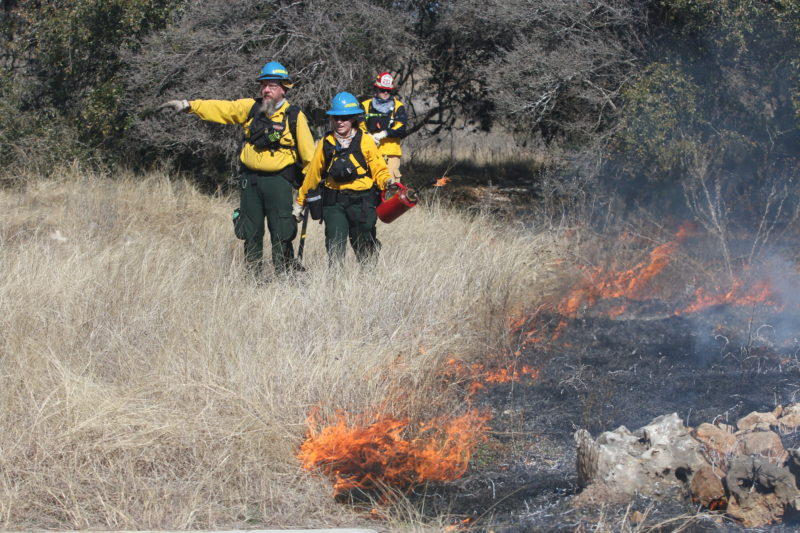
Travis County Parks department land management crew supervisor Jayson May, left, and land management technician Maranda Burhans, center, plan out the next burn swatch as a Pflugerville firefighter monitors the burn boundary during the prescribed burn at Milton Reimers Ranch where various departments worked together to keep the fire under control. Adam Shellooe/Reporting Texas
Tabor coordinates burns with firefighters and those in charge of training operations. “We’re trying to pair up all these organizations [to make] sure our burns are as unified as they can be,” Tabor said.
All federal land management agencies, including the forest and park services, the Bureau of Land Management, the Department of Indian Affairs and U.S. Fish and Wildlife Service all follow the same training and burn protocols. “We talk on the same level. It’s a standard,” said Nate Suida, a burn boss with the Bureau of Land Management.
Suida, like most burn bosses, relies on a network of trained personnel from multiple organizations to carry out a burn. At Camp Bullis, a burn team from Fish and Wildlife that operates out of the Balcones Canyonlands National Wildlife Refuge helps. Suida also brings in his Bureau of Land Management team, along with their equipment from Arizona, to help.
At Laughlin Air Force Base in Del Rio, Suida orchestrates Bird Air Strike Hazard burns adjacent to airport runways on a four-year schedule to prevent damage to planes from wildlife.
Grass next to air strips is kept short and grass clippings are burned to discourage ground-dwelling birds such as killdeer and meadowlarks.
When larger raptors, which can weigh two to three pounds, swoop down to eat these birds for lunch, the risk to planes increases dramatically. “If you’re smacking a little killdeer versus a red tail (hawk),” Suida said, “that’s going to be quite a difference on the impact on that airplane.”
Prescribed burns are also used on military bases to protect people and animals from disease.
At Lackland Air Force Base in San Antonio, dogs and their handlers are trained to detect drugs and explosives. Chagas disease, a tropical disease caused by parasitic insects nicknamed “kissing bugs,” which can kill both people and animals was found in the blood of 16% of the military working dogs at Lackland in 2007. These bugs prefer woodlands, so Tabor utilizes fire to reduce tree cover and create the grasslands that the bugs don’t like.
Under investigation
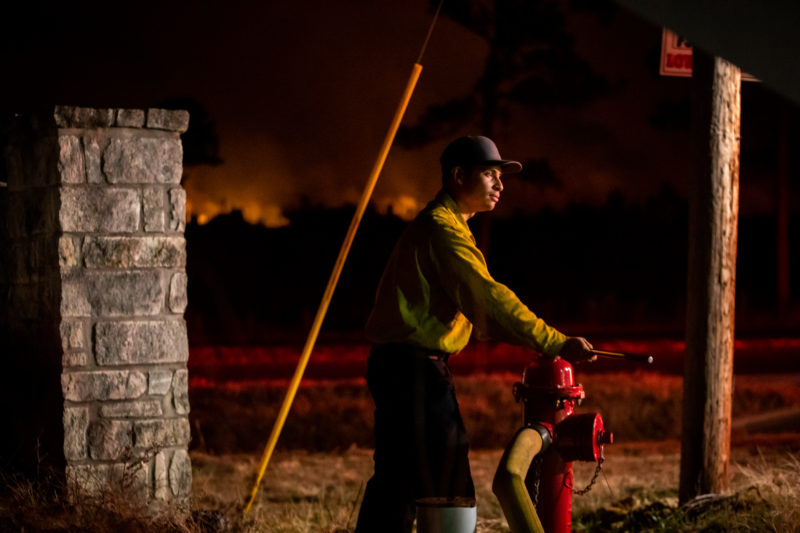
A firefighter from Bastrop County refills his truck before rejoining the effort to contain the Rolling Pines fire at Bastrop State Park on Jan. 18, 2022. Pending an investigation, prescribed burns are now suspended at the park. Michael Minasi/KUT
Meanwhile, January’s Rolling Pines at Bastrop fire remains under investigation to determine what went wrong.
Texas A&M Forest Service assembled an independent panel of experts in February to review how the fire was planned and carried out. Pending the investigation, prescribed burns at Bastrop and Buescher State Parks have been suspended.
Mark Moseley, a rangeland ecologist with Texas A&M, managed more than 300 prescribed burns when he worked for the U.S. Department of Agriculture. Now he teaches people to do prescribed burns as part of the Edwards Plateau Prescribed Burning Association. He credits past professors at Texas Tech and Oklahoma State with developing the science behind prescribed burns best practices.
“It’s a standard operating procedure. We make sure everyone on the fire knows what their role is and if something bad happens they know what to do, they can respond,” he said. “However, there’s no guarantee.”
“It’s easy to have 2,000 good burns,” Moseley said, “and then one bad thing happens and everybody goes ballistic.”